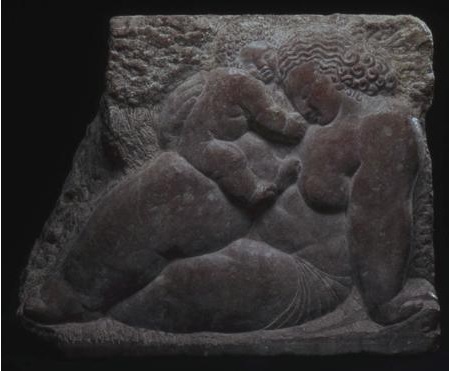
Alice Carr de Creeft
American, 1899-1996
Maternity, 1932
rose coral
15 × 18 3/4 × 5 in.
SBMA, Gift of the Artist
1958.38

Alice Carr de Creeft, undated photograph
"To do a really good portrait one should be in love with the subject." - Alice Carr de Creeft
COMMENTS
Born in Roanoke, Virginia, at the age of ten the artist moved with her family to homestead at Sun River Valley in Montana. Chasing antelope on pony back and riding Indian ponies to school replaced piano and dancing lessons which most girls of her age engaged in. Of her experience in Montana she recalls, "As a child prodigy I was taken to see Charlie Russell in Great Falls. I remember a little beeswax bear in his hands better than I remember him, so I guess I was too young."
Moving to Washington, she finished high school there. While in Seattle she produced a small fountain sketch for the Architects Show. Mrs. de Creeft ventured to New York to study at the Art Students League. Later, while studying at the Art Institute-in Chicago under Albin Ploaschek, the sketch which she had done in Seattle was to become a reality in the Memorial Rose Garden in Woodland Park. She later executed a twenty-two-foot relief, a tribute to President Warren Harding who had made his last public appearance before his death administering the oath of allegiance to the Boy Scouts in Woodland Park.
After a stint in Honolulu modeling surfers, she went to Paris to study under Antonie Bourdelle at L'Academie de la Grande Cahumiere and Edward Navallier at Ecole des Animaliere. Under Jose de Creeft, who she was later to marry, she studied direct carving and wood and helped him finish a large commission in Mallorca. They had two children, Hilliam, now a bush pilot in Alaska, and a daughter, Nina, who does soft sculpture in Chicago.
The de Creefts set out for New York to arrange for the first exhibition of his work. Constantly back and forth between New York and Mallorca, in 1936 the outbreak of the Spanish Civil War found Mrs. de Creeft and her two children returning to New York as refugees on the British battle cruiser, the Repulse.
Setting up home in Santa Barbara, where she had previously visited in 1921, Mrs. de Creeft executed the Santa Barbara prize winning floats, the Ferdinand and the Taj Mahal for the 1937 and 1938 Tournament of Roses Parades. She began to work primarily with animal portraits, starting with Zamal, a desert-bred Arabian stallion pastured by the Hearst Castle in San Simeon. He was the first in the long line of champion animals that have trooped through her life. Later she was to do Needles, Nizzam, The Cad, Cap and Gown, Buckpasser and a number of Santa Barbara Polo Club personalities on their mounts. Recently she was commissioned by the Smithsonian Institution to sculpt Secretariat. She has done a number of horses and dogs for the Cynthia Wood Stables in Montecito.
[She traveled] thousands of miles every year in her van accompanied by her dog and a shotgun, doing commissions all over the country. The artist states, "To do a really good portrait one should be in love with the subject. The advantage of working from life is that one does fall in love with a truly fine animal." Alice de Creeft is in love with life itself, and all those who have come to know her share in this love.
- Press Release, Gallery de Silva, Montecito Village, March 1, 1980
SBMA CURATORIAL LABELS
The year that Carr carved this relief, she had newly become a mother. In the 1930s, she and her husband, José de Creeft, also a sculptor, split their time between New York, France, and Spain. These flattened, generously proportioned bodies, which seem to emerge from the rock as if of their own accord, exemplify the studied primitivism achievable through the direct-carve technique that Carr and her husband espoused. Following her divorce from de Creeft, Carr continued to practice as a sculptor, specialized in the representation of animals. She is perhaps best known for her life-size bronze portrait of the triple-crown winner, Secretariat.
- Highlights of American Art, 2021
